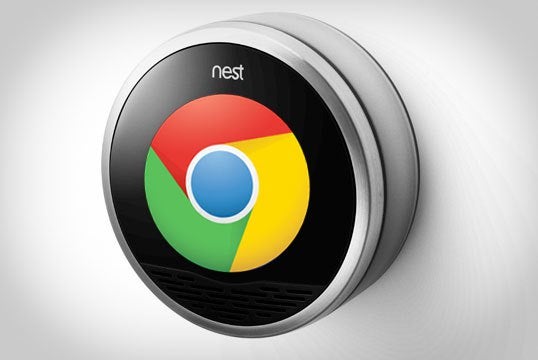 On Monday, Google announced it is spending $3.2 billion to buy Nest Labs, the trailblazing company funded through its Google Ventures program and responsible for transforming “unloved” home products into beautiful, smart appliances. That’s a lot of money for a business with only two products: a thermostat and a smoke detector. Nest is not exactly reinventing the wheel, right? Well, actually they are.
On Monday, Google announced it is spending $3.2 billion to buy Nest Labs, the trailblazing company funded through its Google Ventures program and responsible for transforming “unloved” home products into beautiful, smart appliances. That’s a lot of money for a business with only two products: a thermostat and a smoke detector. Nest is not exactly reinventing the wheel, right? Well, actually they are.
Welcome to the Smart Home
Google’s move is a starting shot in the race to become the go-to smart home provider, putting in place stepping stones to realizing a future in which our homes will become one ecosystem – integrated and functioning as a whole. Customers are looking for smart appliances that can notify you when they are wasting energy or not performing properly. Plus, these innovative technologies provide customers with more opportunities to engage with and benefit from other cost- and energy-saving solutions, like demand response, rooftop solar power and electric vehicles. This puts customers in the driver seat, giving them insight and control over their daily lives in ways never before imagined (even if just to use automated, “set-it-and-forget-it” functionality).
The Nest thermostat learns household behaviors and habits and sets temperatures at the optimal comfort and energy-saving level accordingly. Nest also enables residents to control their electricity remotely and provides the interface needed to participate in demand response, an energy management program that rewards participants for conserving energy during peak, or “rush hour,” times on the electric grid.
Many utilities are already taking advantage of Nest’s ability to better manage the flow of energy into and out of homes. We wrote about one such program when Austin Energy partnered with Nest to launch its residential demand response pilot in 2013. Austin Energy’s new program provides participants with an $85 rebate per thermostat in exchange for the ability to raise the Nest thermostat’s temperature a few degrees when electricity supplies run thin and energy prices spike.
Meanwhile, Nest’s other product, Protect, is completely revamping the way we interact with the annoying, chirping smoke detector of yore. Whether you accidentally burnt the popcorn or a true emergency happens while you’re away, Protect will know the difference.
But, while these gadgets are cool and helpful, what motivated Google to spend twice the amount they paid for YouTube to acquire Nest?
Crossing the Energy Divide
In August, I wrote about smart homes and how we are on the cusp of new technologies for home energy management systems (HEMS) with devices like Nest and others, which promise to revolutionize our lives. The problem thus far has been that technological advances in the electric sphere tend to benefit the utilities more than the consumer. For example, by the end of 2015, approximately “45% of all U.S. households will be served by smart meters but as few as 10% of those meters will be enabled for two-way communications” via HEMS. This two-way communication is what gives customers leverage over their power usage and creation, as well as what helps save them money.
Google’s vision is to close this gap with Nest.
It is not just one thermostat here and a smoke detector there; it is the fully-integrated automation of your home with Nest acting as the sleek hub for all the activity therein. The possibilities are endless when considering third-party app developers are providing answers to problems we didn’t even realize we had yet! Recall the days before the iPhone and social media. Energy management and home automation sit at that same precipice, ready to take us into the future, especially as “serious innovation in core gadget lines like smartphones and televisions is coming to an end,” according to Wired Magazine.
In Texas, if residential consumers were benefiting from demand response at its full potential, enabled by technologies like Nest, we would not have an “Energy Crunch” problem. We would be able to load-shift when the electric grid is strained, avoiding the need to fire up polluting coal plants.
According to GigaOm, “technologies that manage home energy consumption just hit the big time.” And after shutting down its home energy software experiment, PowerMeter, just a few years ago, Google is now at the forefront of home energy hardware and software development. “Nest isn’t just an energy software and hardware company — it’s evolving into more of a consumer electronics and internet of things company. If Google is able to give Nest the resources it needs to get its thermostat and software out there at a much greater scale,” says Giga Om, “that means lower energy consumption ahead for homes that adopt it. And that’s a good thing overall for the world and for lowering carbon emissions.”
Competition is Driving Expansion
While Nest provides that same “sexy-cool” design that Apple is known for (it was, after all, co-founded by former Apple executive Tony Fadell, who helped create the iPod and iPhone), it isn’t the only player. AT&T is getting into the game with its new Digital Life services that enable home automation and integration of energy, home security, water leak detection and more. Comcast’s competing service is Xfinity Home, teaming up with EcoFactor, a cloud-based energy management platform.
It’s interesting that the, previously disparate, telecom and energy utilities are now competing with each other (and Google) in this brave new world of complete smart home services. As Wired explains, “Nest has made no secret that it doesn’t plan to stop at the thermostat and the smoke detector. It wants to take all the mundane but important technologies you use every day in your home and make them smarter and more pleasing — what Fadell calls the ‘conscious home.’”
EDF is working diligently to bring the understanding and availability of these technologies to the marketplace. With Google’s announcement, innovative energy solutions are going mainstream, which means a better life for all of us and a cleaner environment in which to enjoy it.










